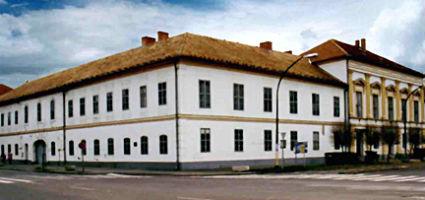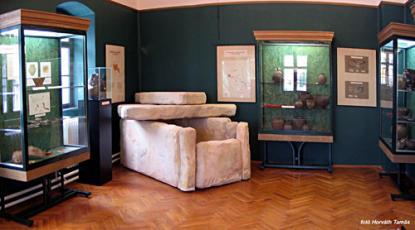2024. April 26. Friday
Museum of the Hajdúság Region - Hajdúböszörmény
 |
Address: 4220, Hajdúböszörmény Kossuth Lajos utca 1.
Phone number: (52) 229-038, (52) 561-182
E-mail: info@hajdusagimuzeum.hu
Opening hours: Tue-Sun 10-16
|
The exhibition has closed for visitors.
2004.05.21. - 2004.08.31.
Museum tickets, service costs:
|
Ticket for adults
|
300 HUF
|
|
|
Ticket for students
|
150 HUF
|
|
|
Ticket for pensioners
|
150 HUF
|
The creators of the new culture sometimes occupied with agriculture built camps without permanent buildings. Most of these camps served to hold burial ceremonies. Besides the grave caves that are commonly excavated we may find flat graves proving the survival of the notion of megaliths.

The deceased were often provided with rich accessories. Sometimes human and animal remains were found in mutual graves, in some case cow bones ornamented with burial presents suggested the importance of the animals in the lives of people and also in the religion of that particular nation.
The pottery with the shape of funnel mouth designates the first tiller of the soil and farming culture, which formed in the first millennia. The society that formed around Lublin, which made pottery, can be traced back to the turn of the 2nd and 3rd millennia. Around this region this period can be traced back over a thousand years. It is one of the most important prehistoric culture in the history of the Polish culture.
These people changed their lifestyles by settling. Large centralized settlements were born surrounded by several smaller settlements.
The research in cemeteries betrays very differentiated costumes of burials. The sepulchers, which sometimes were ten meters long and several meters high, are the most significant burial mementos in Poland. Sometimes they are even called Polish pyramids. In the central grave one person was buried, it was this person for whom the monumental buildings were constructed. It could be the leader of the group, the priest, or the any member of the leadership.
Among the everyday occupation of the settlements we may mention handmade pottery in different quality and form. In some cases stone tools were made, for example axe or a really sharp chisel. Tools, but also jewelry made of the bones of wide animals were also found in great numbers. The buttons that were also found in great numbers prove that the people of that period knew how to weave and the counterweights found also prove that vertical weaving was also known that time. The plough with wheals pulled by the ox was a very important invention.

The deceased were often provided with rich accessories. Sometimes human and animal remains were found in mutual graves, in some case cow bones ornamented with burial presents suggested the importance of the animals in the lives of people and also in the religion of that particular nation.
The pottery with the shape of funnel mouth designates the first tiller of the soil and farming culture, which formed in the first millennia. The society that formed around Lublin, which made pottery, can be traced back to the turn of the 2nd and 3rd millennia. Around this region this period can be traced back over a thousand years. It is one of the most important prehistoric culture in the history of the Polish culture.
These people changed their lifestyles by settling. Large centralized settlements were born surrounded by several smaller settlements.
The research in cemeteries betrays very differentiated costumes of burials. The sepulchers, which sometimes were ten meters long and several meters high, are the most significant burial mementos in Poland. Sometimes they are even called Polish pyramids. In the central grave one person was buried, it was this person for whom the monumental buildings were constructed. It could be the leader of the group, the priest, or the any member of the leadership.
Among the everyday occupation of the settlements we may mention handmade pottery in different quality and form. In some cases stone tools were made, for example axe or a really sharp chisel. Tools, but also jewelry made of the bones of wide animals were also found in great numbers. The buttons that were also found in great numbers prove that the people of that period knew how to weave and the counterweights found also prove that vertical weaving was also known that time. The plough with wheals pulled by the ox was a very important invention.
